On Thursday 11th September Poultry CRC ran an egg quality workshop at the University of New England. Twenty two egg producers from across Australia were in attendance for the single-day event to hear presentations from four key experts in the field, and to participate in practical hands-on activities.
Dr Greg Parkinson from Livorno Consulting began the day speaking about the importance of pullet rearing. Greg captivated delegates with his vast hands-on experience. He presented data from his research conducted with AECL funding, as well as provided observational data from his years of industry experience. Greg stressed the importance of pullet uniformity at six weeks of age, outlined his experience of ‘flushing’ feed intakes in the transition to production, and highlighted the need to control cannibalism. Throughout his presentation there were many questions from the delegates, each keen to tap in to Greg’s knowledge and to have their own experiences discussed.
Dr Greg Underwood from Bioproperties followed with a presentation on managing bird health, and the potential impacts of management practices on egg quality. Major topics of Genetics, Nutrition, Husbandry & Environment and Health were covered. He gave detailed analysis of egg defects (internal and external), advances in genomic selection and the importance of nutrition. He encouraged producers to:
- Understand the different technical aspects of egg production, and develop a Quality Assurance programme to identify Control Points + Key Performance Indicators for each
- Implement a Continuous Improvement Programme to improve egg numbers and shell quality
- Ensure regular contact with technical expertise where required (e.g. husbandry, nutrition, health)
- Review breed information and technical presentations regularly
- Review research outcomes from the peak funding bodies (Poultry CRC, AECL, RIRDC)
Along with Greg Parkinson, Greg Underwood linked egg production to rearing, stating “too often we look at issues in laying in isolation to what happened in rearing”.
Associate Professor Julie Roberts from UNE then covered internal and external egg quality parameters, and outlined her research on shell translucency and ultrastructure. She highlighted consumer preference for yolk colour, a particular range of albumen viscosity and the importance of safety of egg contents (microbiologically). Julie ran through the physical formation of the egg, linking this to resultant egg shell quality. The importance of an intact cuticle layer was covered in some detail as this layer provides a barrier to bacterial penetration. She then gave a detailed account of other factors affecting egg shell quality, such as husbandry and management, flock age, bird strain, stress, disease and nutrition.
After lunch a practical session demonstrated useful on-farm methods and techniques for measuring egg quality. Delegates were each able to bring their own experiences, questions and in some cases eggs along. This time allowed producers to question the four presenters on aspects of their own operation, and areas of particular interest or concern to them. Many felt that this time was invaluable with free access to both our speakers and other producers.
Finally, Dr Kapil Chousalkar for the University of Adelaide gave a talk on overall egg safety ‘from farm to fork’. Kapil’s research focus has been on Salmonella on layer farms. He has recently completed a CRC project titled “Epidemiology of Salmonella on layer farms” which is currently undergoing review, prior to release. Additionally, Kapil has a new CRC project “Epidemiology of Salmonella species on free range farms” which has just kicked off.
Kapil outlined common sources of Salmonella across the egg production cycle, with particular focus on the in-shed environment. While not providing an absolute control, Kapil summarised that on-farm control can be achieved via biosecurity and hygiene, probiotics, vaccination, organic acids and egg washing. He then went on to ‘quiz’ delegates about their own on-farm practices relating to cleaning and/or sanitising items such as suction cups, candling booths and egg fillers. Kapil followed with the importance of egg washing in reducing bacterial penetration of the egg shell.



